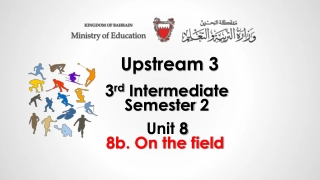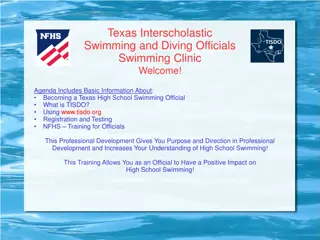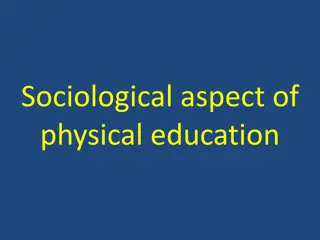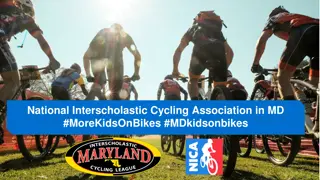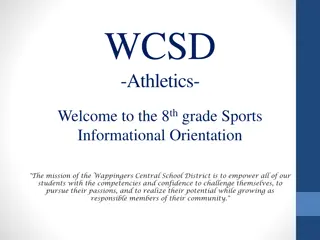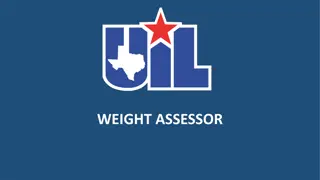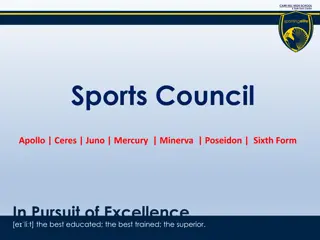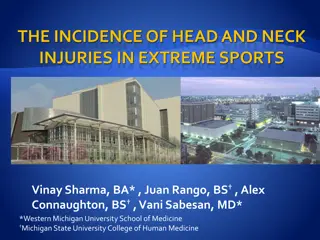The Impact of Interscholastic Sports on Student Well-being
Interscholastic sports play a vital role in enhancing students' overall education and well-being. Organizations like the National Federation of State High School Associations emphasize the importance of sports in supporting academic achievement, good citizenship, and equitable opportunities. Research highlights the physiological benefits of sports participation, such as improved cardiovascular health, strength, flexibility, and weight management. Regular engagement in athletics also reduces the risk of various diseases and negative behaviors, contributing to better academic performance, lower absenteeism, and decreased dropout rates among student athletes.
Download Presentation

Please find below an Image/Link to download the presentation.
The content on the website is provided AS IS for your information and personal use only. It may not be sold, licensed, or shared on other websites without obtaining consent from the author. Download presentation by click this link. If you encounter any issues during the download, it is possible that the publisher has removed the file from their server.
E N D
Presentation Transcript
The Value of Interscholastic Sports
Introduction Proponents of high school sport programs believe that sports contribute to the overall education of students.
National Federation of State High School Associations Mission Statement: States that it serves students by providing leadership for the administration of education- based Interscholastic activities, which support academic achievement, good citizenship, and equitable opportunities.
National Association of State Boards of Education Claims the purpose of high school athletics is to enhance the whole school experience for all students. Academic achievement must always be considered the priority.
Research findings about physiological benefits Enhanced functioning and health of cardiovascular and muscular system Improved flexibility, mobility, and coordination Increased stamina and strength Improved ability to maintain weight Increased likelihood of maintaining weight
Regular athletic participation will decrease the risk of diabetes, heart disease, obesity, and other related diseases. Non-participants are 49% more likely to use drugs and 37% more likely to become teen parents than those who spend one to four hours per week in extracurricular activities (United States Department of Education. No Child Left Behind: The facts about 21st Century Learning. Washington, DC: 2002.) Students participating in organized sports were 25 percent less likely to be current cigarette smokers (American Journal of Health Behavior, 2004)
Participation in extracurricular activities benefits the student Participants have higher GPAs than non- participants(2.84 to 2.68) Participants have lower absenteeism than non- participants (4.9 days to 10.8 days) 75% of participants were A or B students in high school Reduced the drop out rate by 40 %. (Holloway, J. H., 2002) The mean dropout percentage for athletes was 0.6 percent vs. 10.32 percent by non-athletes.
Participation in extra-curricular activities linked to success in school Music students scored about 11 percent higher than non-music students on the 2001 SAT (College Entrance Examination Board). Discipline referrals for athletes ran at a 33.3 percentage while the referral percentage for non- athletes was 41.8 percent. Students who took part in more vigorous sports like soccer or football or skateboarding, do about 10% better in math, science, English and social studies classes (Medicine & Science in Sports & Exercise, August 2007).
Increased Graduation Rate The mean graduation percentage for athletes was 99.4 percent as compared to 93.5 percent for non-athletes. National graduation rate in 2011 77.7% (Iowa ranks first with 88%)
High school seniors who participated in extra- curricular activities by college plans 50 43 45 37 40 35 30 25 25 25 17 20 15 14 15 11 11 10 5 5 2 5 0 Has college plans No college plans University of Michigan, Institute for Social Research, Monitoring the Future, 2010.
How former high-school athletes have benefited 92% said participating in high school athletics made their high school experience more positive 87% said the lessons they learned while participating have helped them as adults 71% earned a post-secondary degree 77% employed full-time 95% of Fortune 500 CEOs participated in high school athletics
Athletics popular among high school students Rank of Importance According to Students 40% athletics 32% school clubs 23% music/performing arts 14% academic clubs 10% newspaper/yearbook 9% student government 55.5 percent of students enrolled in high schools participate in athletics Non- Sports 22% Acade mics 40% Sports 38%
Summary of the Benefits of Interscholastic Sports Students who participate in athletics tend to: Have maximized physiological development Be less likely to use drugs, tobacco, or suffer from health problems Have a higher GPA Have lower absenteeism Have a higher graduation rate Have a high success rate after high school
References American Academy of Pediatrics Committee on Sports Medicine and Fitness. (2001). Organized sports for children and preadolescents. Pediatrics, 107(6), 1459-1462. American Journal of Health Behavior, 2004 Barber, B.L., Eccles, J.S., & Stone, M.R. (2001). Whatever happened to the jock, the brain, and the princess? Young adult pathways linked to adolescent activity involvement and social identity. Journal of Adolescent Research, 16, 429-455 Broh, B.A. (2002). Linking extracurricular programming to academic achievement: Who benefits and why? Sociology of Education, 75, 69-91 College Entrance Examination Board
References Holloway, J. H., 2002. Extracurricular Activities: The path to academic success? Educational Leadership, 57(4), 87-88 Medicine & Science in Sports & Exercise, August 2007 National Federation of State High School Associations. (n.d). Mission Statement. United States Department of Education. No Child Left Behind: The facts about 21st Century Learning. Washington, DC: 2002. University of Michigan, Institute for Social Research, Monitoring the Future, 2010.

 undefined
undefined



























